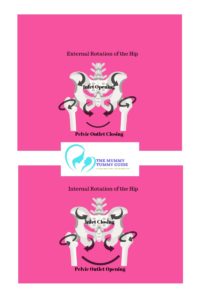You have just confirmed your pregnancy and you are excited to start this new journey.
Your mind is racing trying to think of all the things you need to prepare for your baby.
Which strollers are the safest? The latest sleeping technology. What about toys? Should you try Montessori?
The list is endless.
Looking after you
But what about you, mom? What do you need to do to get your body and mind prepared for the most incredible, life-altering journey known to mankind?
How are you going to make sure you are baby ready?
Many expecting mothers overlook this crucial detail, but no worries – this article will detail how to get ‘Baby Ready’ in 6 simple steps, for a smoother labour, delivery and recovery.
Step 1: Know your Womanatomy
If you ask the average expecting mom to give a visual description of the baby in the growing tummy, they would not have a clue.
We can all admit that the process of child birth is pretty amazing, but can we explain what is happening?
How about delivery? Can you make sense of that process?
If your answer is no, you are not alone.
Knowledge gap
In a poll surveying over 2,000 women, 57% of the women surveyed admitted they don't know as much about women's anatomy as they should.
Forty-two percent wished they had a better understanding of what the different organs in the reproductive system do.
Over half (59%) identified the uterus as a different body part too.
Fear-tension cycle
In the 1920s, Grantley Duck-Read described what has become known as the "Fear-Tension-Pain" cycle.
He suggested that fear causes the pregnant person to become tense, and that tension increases pain.
The increased pain, in turn, increases fear, and the cycle repeats.
Dick-Read suggested interrupting this cycle in two ways:
- Reduce fear by educating expectant mothers about what is happening during childbirth.
- Reduce tension by promoting relaxation, thus reducing the pain.

Preparation is key
So what is there to know? Well quite a lot, but for the purpose of this article we will look at the four most important.
- The pelvis: The ligaments of the pelvis relax during pregnancy to make the bones of the pelvis mobile, allowing for movement and easier delivery. Knowing this can help to guide how you exercise during pregnancy to help facilitate this process as well as positions you can utilize to increase the size of the pelvic outlet during labour for an easier delivery.

- Vaginal Rugae: These are ridges or folds formed in the vagina that smoothen out during labour, allowing the vagina to expand during child birth. It’s also important to note that it can take up to three months for rugae to return to normal after delivery, so consider this when returning to sex after baby.
- The pelvic floor and the core: Instead of getting fixated on ‘the correct way to breathe’ as taught for years in traditional lanoze class, learning the relationship between the core and pelvic floor and practicing more mindfulness can be helpful in relaxing the pelvic floor during labour and reducing tension. This will help to reduce stress and strain of the pelvic floor and the core during delivery.
- The perineum: This is the area of skin and muscle between the vagina and anus. The pressure of giving birth on your perineum means it may tear or need an episiotomy (surgical cut) when your baby is born. Up to 9 in 10 first-time mothers who have a vaginal birth will have some sort of tear, graze or episiotomy. An episiotomy is a non-routine surgical cut to the vaginal opening, which is intended to prevent more serious tears. Up to one in 10 women experience pain for up to 18 months after a serious perineal tear or episiotomy.
Perineal massage
A perineal massage can help with this.
Research has shown that perineal massage reduces the chance of a perineal tear or episiotomy.
One review showed that pelvic floor exercise and perineal massage reduced perineal trauma.
Perineal massage involves massaging the area between the vagina and anus during late pregnancy, starting at about 35 weeks.
With the help of a professional, some women are able to massage their perineum themselves, while others prefer to get their partner to help or just the pelvic health professional.
Step 2: Get Active
Exercising during pregnancy can be extremely beneficial.
It can reduce complications, prevent pregnancy related issues such as gestational diabetes.
It can also help to strengthen crucial core and pelvic floor muscles that are under stress during pregnancy.
This also gives you a head start for your postnatal recovery.
Other important roles of exercise during pregnancy, is to improve mindfulness and increase flexibility, especially in the pelvis.
Step 3: Choose your birthing partner
Emphasis on choose; you do not have to assume this is your romantic partner or the father of your child.
You can choose your mother, sister, friend, a doula or a midwife.
The choice is yours.
It is also a very important one.
Supportive partners
It has been shown that having a supportive birth partner present at birth can lead to a better birthing experience and can even make labour progress more quickly.
Your birthing partner is there solely to serve you and ensure you are as comfortable as possible during delivery and advocate for your rights in the event you are unable to do so.
Choosing your birthing partner early is a good idea. This way they can accompany you to your doctor's appointments and help you prep for the big day (see step 5)
Step 4: Know your birthing plan
A lot of time we place our entire birthing plan in the hands of the doctors with no idea of why or how it is going to unfold.
Speak with your doctor and ensure you have a good understanding of what is expected.
Will you be having a c-section or vaginal birth? Why are you having a c-section?
Even if you are scheduled to have a vaginal delivery, have a plan in case you have to do a c-section.
Your doctor
Discuss all of this with your doctor.
Can you take your birthing partner in the delivery room? Do you need to speak with someone so this can happen or do you need to choose another hospital?
Ask your doctor at what contraction interval should you make your way to the hospital.
Ask them to explain to you how to count it.
It’s much harder to understand during labour when hormones, emotions and tensions are high. It is best to prepare before.
Step 5: Prep for the big day
Think of this as a dress rehearsal, plan the scenario and plan the steps.
Your water broke, what is the first thing you are going to do?
It is best to know this before the big day so that on the actual day you can be calm and collected.
By this point, your birthing partner knows their role.
Snacks
They know to keep you fed and hydrated as the labour process can be a marathon at times.
You should know what you would like to eat or snack on before; if you are having a c-section you should ensure you have your last meal at the appropriate time.
If it is advised that you do not eat before then stay hydrated and in the case of a vaginal delivery, have something for after.
Plan in advance
Have this planned out before the big day.
Familiarity and a sense of knowing leaves the mind free to handle the task at hand.
If things get out of control on the big day, even just the familiarity of your birthing partner and the exercises you practiced can help you to feel relaxed and calm.
Step 6: The After Birth Plan. All hands on deck
It is best to know before the baby gets here who will help you out in the first few weeks.
It is equally important to know the type of help you would like.
Do you want help with your other kids, the household, preparing meals, or do you want help with feeding the baby?
Hired help
The truth is you will need help and if family is not available, consider paying for help even 2-3 days per week and arrange this before the baby comes.
Think of it this way; you have a hole in your womb even in the case of a vaginal delivery. There is a wound there even if you can't see it, so your body needs time to heal.
Check-ups
It is also important to do your check-ups after baby. These are just as important as your baby's check up.
Add seeing a pelvic floor Physical Therapist six weeks after delivery to your list of things to do.
They will check for pelvic floor dysfunctions such as incontinence, weakness, diastesis recti (separation of the abdominal muscles), any maladaptive posture and positioning that can impede healing and lead to further medical issues later on.
So while you fantasize on the perfect blue, pink or yellow to paint your baby’s room, remember the best preparation for your baby is a healthy, calm and baby-ready mom who followed these six steps.
If you would like to learn more about my BBR (Be baby ready) program, follow me at the women’s health physio on Instagram or email me at [email protected].
Kimberly Hoffman is a Pelvic Health Physical Therapist & Creator of The Mummy Tummy Guide.







